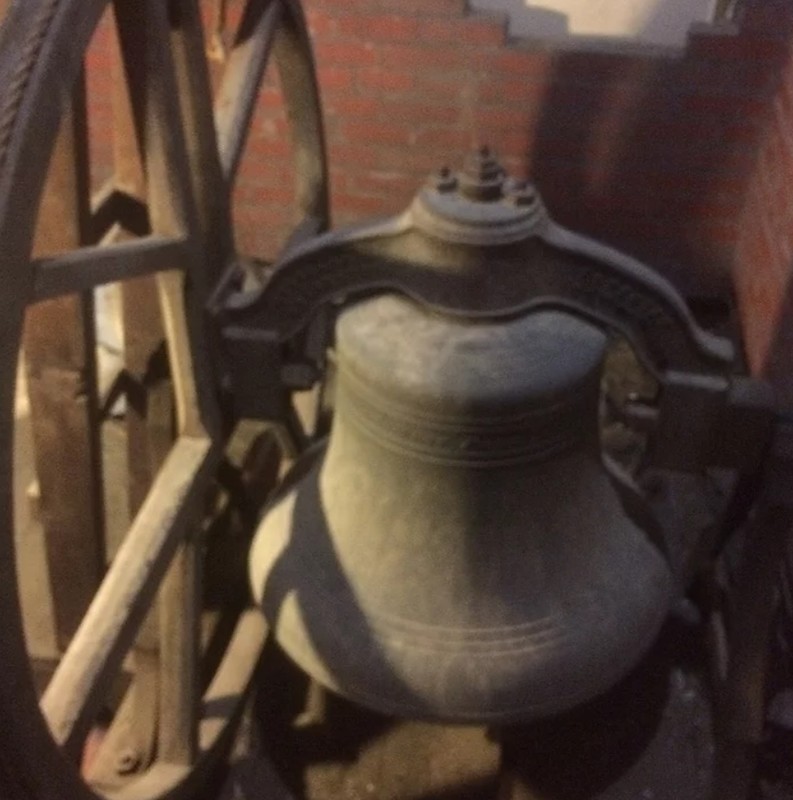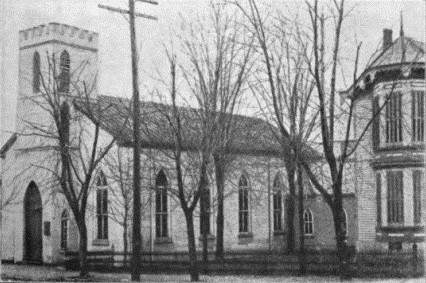Christ Episcopal Church
Introduction
Text-to-speech Audio
Images
Christ Episcopal Church.

Interior of the church.

The church’s bell was made in 1870 by West Troy, New York’s Meneely Bell Foundry.

This photo of the church in 1902 shows how little the exterior of the structure has changed.

1911 photo of the church and parish house in the background.

Backstory and Context
Text-to-speech Audio
When Reverend William Ward arrived in Clarksburg in the mid-1930s, he was the first Episcopal minister in the area. Though he stayed only a few years, it was long enough to establish ties to central Episcopal administration. In 1852, Reverend Robert A. Castleman, a newly ordained deacon, was sent to Clarksburg as a missionary. By this time, Clarksburg had a sizable Episcopal population but no permanent place of worship. Castleman ardently pursued financing a physical place of worship while working to expand the parish. Construction on the Christ Episcopal Church began just months after Castleman’s arrival in Clarksburg.
Beyond soliciting donations from the new church, Castleman was also heavily involved in the design and construction. Apocryphal accounts suggest that Castleman modeled the structure on a parish church near Dublin, Ireland. While this claim is tenuous given the church’s Greek and Gothic Revival architecture, it is clear that Castleman participated in ways such as hand-selecting lumber. During an 1855 visit from an Episcopal bishop, the visiting clergyman praised Castleman for his, “indefatigable efforts.” The same bishop also consecrated the site on April 20th, 1856. Unfortunately, Castleman was not present to revel in the fruits of his labor for long; the deacon departed Clarksburg in 1858.
The Christ Episcopal Church is a moderately Gothic Revival structure. The defining features are tall lancet windows and a three-stage crenellated tower on the facade. Ornamentation on the exterior is kept to a minimum and large flat planes define the walls. While the church certainly belongs to the canon of Gothic Revival, the basic proportions and placement of features on the building are reminiscent of Greek Revival architecture more so than Gothic. The placement of the tower in the center of the facade, rather than on a side, is particularly revealing of the Greek Revival influence. The simple whitewashed exterior was the standard for Christian churches of almost all denominations, and the Christ Episcopal Church maintains this aspect to today.
Following Castleman’s departure from Clarksburg, church services were limited to a bi-montly schedule. When the Union Army occupied the area around Clarksburg in 1861 — mostly over fears that Confederate raids would aim to disrupt rail lines in the area — the Christ Episcopal Church was requisitioned to garrison Union troops. This led to significant interior damage and regular services were not resumed until 1872. In 1891, Christ Episcopal Church began expanding in several ways. It acquired the rectory adjacent to the church and also expanded the main church building. This renovation was completed in 1893 and included enlarging the altar area, adding a vestry room and pipe organ, removing upper slave galleries, and moving pews to create a central aisle. At some point in the late nineteenth century the church also acquired a large bell. It was made in 1870 by Meneely Bell Foundry in West Troy, New York and rung before church services.
The third and final structure to complete the Christ Episcopal Church cluster is the parish house. A.P. Gladden, a Clarksburg based architect, designed the first version of this building which was completed in 1910. Just a few years later, in 1925, the parish house was completely reconstructed according to plans by Boston architects Cram and Ferguson. The new parish used a tapestry brick design and has a Jacobethan architectural style. The Christ Episcopal Church buildings have changed extremely little since 1925. The only major changes to any of the buildings have been the addition of stained glass memorial windows in the main church building. With over one hundred sixty years of use, the Christ Episcopal Church is the oldest religious facility in Harrison County to continuously host the same denomination.
Sources
Chambers, S Allen. Christ Episcopal Church, SAH Archipedia. January 1st 2012. Accessed April 1st 2021. https://sah-archipedia.org/buildings/WV-01-HR8.
Chambers, S Allen. Clarksburg, SAH Archipedia. January 1st 2012. Accessed April 1st 2021. https://sah-archipedia.org/essays/WV-01-0007-0005-0001.
Historical Bell at Christ Episcopal Church Clarksburg, West Virginia , Christ Episcopal Church. Accessed April 1st 2021. https://www.christchurchclarksburg.com/our-bell.
The History of Christ Episcopal Church, Clarksburg, West Virginia, Christ Episcopal Church. Accessed April 1st 2021. https://www.christchurchclarksburg.com/history.
Pauley, Michael J. Clarksburg Downtown Historic District, National Register of Historic Places. July 19th 1982. Accessed April 1st 2021. https://npgallery.nps.gov/GetAsset/ce68bc09-5ff0-4266-8041-89c13538848d.
Peterkin, G. W., A history and record of the Protestant Episcopal church in the diocese of West Virginia: and, before the formation of the diocese in 1878, in the territory now known as the state of West Virginia. Charleston, W. Va.: The Tribune Company Printers, 1902.
Clarksburg Visitors’ Bureau. Accessed April 1st 2021. https://www.clarksburgvisitorswv.com/historicworship.aspx.
Christ Episcopal Church. Accessed April 1st 2021. https://www.christchurchclarksburg.com/.
Christ Episcopal Church. Accessed April 1st 2021. https://www.christchurchclarksburg.com/our-bell.
Peterkin, G. W. “Christ Church.” 1902. Wikimedia. Accessed April 1st 2021. https://commons.wikimedia.org/wiki/File:Christ_(Episcopal)_Church,_Clarksburg,_W.V.jpg.
“Christ Episcopal Church and Parish House, Clarksburg, W. Va.” 1911. West Virginia & Regional History Center. Accessed April 1st 2021. https://wvhistoryonview.org/catalog/006408.
